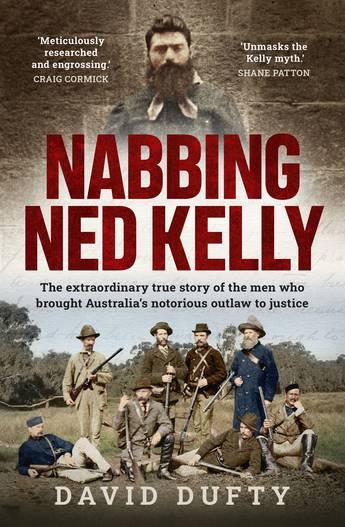
David Dufty’s new book tells the story of the men who brought Ned Kelly to justice.
Ned Kelly is a topic as controversial as the Eureka Stockade, a narrative which divides, and is framed as rebellion vs authority. He was similarly anathema for decades, before a sea change in opinion. Now Kellyana is a publishing category in itself, an area where it is hard to innovate. Dufty, in deciding to tell the story of the police hunt for Kelly, does just that.
That there was another side to the Kelly story is evident to anyone who has read that monumental – if engrossing – doorstopper, the Report of the Longmore Royal Commission. Dufty has followed up its clues by dedicated archival work, uncovering much that was forgotten, or conveniently elided. In particular he focusses on some bit players in the canonical histories, revealing their true importance.
Any study of Kelly’s adversaries in the police necessarily includes the top brass, beginning with Commissioner Standish, damned by many for his Melbourne Club digs and pursuit of the good life. The book is also a tale of three superintendents, Nicolson, Hare and Sadleir, rivals in the pursuit, each seeking the glory of capturing Kelly. All would suffer professionally for errors made during the Kelly Outbreak. Of these four, Sadleir’s reputation is probably highest, given that he set his record straight in a memoir. Dufty differs, reading Standish as shrewd, Nicolson and Hare personally brave but not fit (certainly not physically) for the hunt, and finding Sadleir not ‘particularly bright’.
His real hero is Michael Ward, the only detective assigned to the Kelly gang. Ward, like most in the pursuit and the pursued, had Irish origins. He had first been assigned to Beechworth as a mounted constable, and knew what would be called Kelly country well. As a detective, he spent long periods undercover in the area, his hair and beard grown for a disguise. His difficulty was being low-ranking, and thus frequently overridden or thwarted by his superiors.
The tragedy of Aaron Sherritt is familiar to Kelly aficionados – killed by his childhood friend Joe Byrne when it was discovered he was working with police. What is less well known is that the use of informers (known as fizzgigs) was endemic to the Victorian Police, city and country. It was a modus vivendi that would continue all the way to Agent X, Nicola Gobbo. Though fizzgigs were hated by lower Bohemia, the line between informer and criminal was frequently crossed – even Kelly himself was not immune.
A smart fizzgig, unlike Sherritt, could do well, especially if they had more than one handler/paymaster. They could also undermine police investigations by crafty misinformation. The second ‘bit’ player in this story, King Valley schoolteacher and postmaster James Wallace, played this game to near perfection. Outwardly respectable, actually a Kelly sympathiser, as Nicolson’s fizz he subtly created havoc.
So did the egos of the police involved, which clouded their judgement. The prize of Kelly set Nicolson and Hare at odds, and Sadleir was not adverse to the jostling. At crucial moments, like Glenrowan, Dufty finds that Ward, who had the most relevant experience, was sidelined. Dufty even argues that Sadleir’s order to fire the Glenrowan Inn was motivated by Standish’s imminent arrival by train – and as superior officer, the kudos would be the Commissioner’s.
In making Ward and Wallace major players in the oft-told story, Dufty does tell it differently. The research shines; and so does the telling, which at times verges on becoming a thriller. Police trains crash through barriers; Constable McIntyre flees through the bush at night; Glenrowan’s Tom Curnow fashions a stop sign from a candle and a borrowed red wool scarf.
It is possible to quibble with this book, to find mistakes and omissions. I only regret that the account of Jerilderie did not mention Percy Rollo Brett, who happened to be a former Victorian mounted trooper. He talked down Ned Kelly and Steve Hart from shooting a fellow hostage (an incident used by Douglas Stewart in the play Ned Kelly). Perhaps not coincidentally, that same year Brett’s former wife, the bigamist and detective fiction writer Mary Fortune (W. W.), fictionalised Ned Kelly as heroic and the police as dunderheads.
Dufty finds Kelly not heroic, rather a psychopath who graduated from horse theft to robbery under arms and what might have been a major terrorist incident, had the derailing at Glenrowan succeeded. His disgust with Kelly is palpable, but then he is writing from the perspective of the police. That is unusual in Kellyana, and it is backed up by novel research and sure writing skills. The book is significant, not least as a page-turner.
Will it convince the true believers? Probably not, and the Kelly mill will continue to grind. Among the works forthcoming in 2022 is Aidan Phelan’s novel Glenrowan, in which Detective Michael Ward also plays a significant part.
David Dufty Nabbing Ned Kelly: The extraordinary true story of the men who brought Australia’s notorious outlaw to justice Allen and Unwin 2022 PB 424pp $32.99
Lucy Sussex is a researcher and writer of crime fiction and true crime. She and Megan Brown are completing a biography of Mary Fortune and her criminal son George.
You can buy Nabbing Ned Kelly from Abbey’s at a 10% discount by quoting the promotion code NEWTOWNREVIEW.
Or check if this book is available from Newtown Library.
If you’d like to help keep the Newtown Review of Books a free and independent site for book reviews, please consider making a donation. Your support is greatly appreciated.

Tags: Aaron | Sherritt, bushrangers, David | Dufty, Glenrowan, James | Wallace, Joe | Byrne, Michael | Ward, Ned | Kelly, outlaws, Tom | Curnow
Discover more from Newtown Review of Books
Subscribe to get the latest posts sent to your email.







